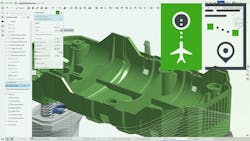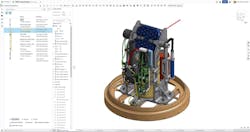How AI-Driven, Cloud-based CAD Supports Efficient Product Design
Engineering and manufacturing companies are upgrading their design systems in lockstep with cloud-based platform adoption. At the same time, CAD (computer-aided design) and product lifecycle management (PLM) are driven by advancements in AI, IoT integration, and a demand for collaborative and compliant design solutions.
According to CAD experts David Katzman, general manager of Onshape and Arena by PTC, and Darren Henry, SVP of General Operations, Onshape by PTC, the demand for cloud-based CAD software that are also feature-rich and integrate seamlessly between tools is central to a shift in the way engineering teams collaborate and innovate.
Two recent Onshape product launches encapsulate this shift, according to Henry. The first can be characterized as a digital expert. “AI is relatively new in the manufacturing and CAD space, and Onshape AI Advisor is a generative AI-powered assistant that sits with you 24/7,” explained Henry. “And it’s actually trained on all the amazing resources that we have related to our products.”
The tool is trained on online documentation, learning content, webinars and videos available in the PTC library and was developed for design teams that are transitioning to a cloud-native system, said Henry. In addition, it helps users tackle difficult problems and optimize designs. Users simply type in their question, and the Onshape AI Advisor provides recommendations and links to additional information. The Onshape AI Advisor runs on Amazon Bedrock, AWS’s service for building generative AI applications.
The second product launch, OnShape Government, was designed to meet the specialized requirements of the International Traffic in Arms Regulations (ITAR), Federal Risk and Authorization Management Program (FedRAMP) and Export Administration Regulations (EAR) on compliance with U.S. government agencies and defense contractors. “This is an area that has had a lot of demand over the past several years,” said Katzman, “and Onshape has not been able to fulfill it until now.”
In the Q&A below, Katzman and Henry take turns answering questions about these new deployments. (The content has been lightly edited for clarity.)
Machine Design: How does the Onshape AI Advisor speed up the design process? For example, can it identify design flaws or suggest improvements in real time? And more importantly, how exactly does AI factor into the decision-making process?
Darren Henry: These are great questions. So, I do want to point out that it’s early days. Onshape AI Advisor is our foundational offering. I think it’s important for everyone to know that Onshape is a relatively new next-generation player in the market space. In many cases our customer base is leaving a traditional file-based on-prem solution and going into these new cloud-native workflows. The cloud-native workflows are quite different.
One of the biggest benefits of Onshape AI Advisor is helping people make that transition. It helps you not only learn the software, which may be where you’re looking for the common commands like “fill” and “shell.” It will help you find those very quickly. But more importantly, we’re utilizing things like data management that is traditionally used in the software world but is relatively new for hardware engineers.
Onshape AI Advisor acts like a sherpa, taking you through these complex workflows. You can really transform the way your company works. That’s the No. 1 use: It is an expert. As engineers are doing different things, it may be that traditionally you’re building a lot of geometry. But maybe you need to route a cable through something, or you need to do something very specific. This is an expert that can actually walk you through difficult design challenges.
And then the last thing is, there are administrative aspects. One of the benefits is you’re deploying software instantly to a team; you can scale to a team; you can downsize; you can democratize how data is shared throughout your whole enterprise and organization. So, this is a tool that can help people get the most out of the software.
READ MORE: CAD/CAM Roundup: Engineering Software Productivity Tools and Services
But you raise an interesting point, which is, can it actually do things like design checking? And can it actually do tasks for you? And ultimately, what people want is, will it help me build geometry and actually do the cadding faster? Well, at this point it doesn’t. But what we see is this is a foundational layer, which will not only improve with every usage. And there’s a lot of reasons for that. It improves with all the new information that we add. And we update every three weeks.
But it will start becoming aware of what you’re doing in the product and we want it to become agentic, which is that it completes tasks for you. What’s nice about this is that we built this on AWS Bedrock. AWS was actually heavily involved in how we built this. So, it's a very solid foundation, and we have very aggressive plans on how to improve it in the future to do those tasks that you mentioned.
David Katzman: As Darren mentioned, Onshape gets updated every three weeks with new features and new functionality. This is an exciting opportunity, where the users are always engaging with this experience. It used to be that you’d learn a tool, and once you learned it…and most of the time you learned it from the person next to you. If you ask anyone how they learned, say SolidWorks or any other tool, it’s usually they learned it from the engineer next to them.
Now that it's more, I get to learn it through this AI Advisor. It’s like a partner, as I’m learning the tool. And more importantly, as the tool evolves your partner is ahead of you, which is usually not the case, right? You’re all learning new things along the way. This is a different way of thinking about learning and using the tool, where we have a partner in crime, in a sense. It’s something we’re really excited about...we’ve always found it challenging to keep people that are users up to date with the software. Now, our tool will help them stay up to date, which is really cool.
MD: Can you walk me through some of those capabilities? And, for example, how would the AI copilot help in version control? Or another example, help in automating repetitive tasks?
DH: One of the things, if you’re not familiar with Onshape, is that it’s fully cloud—we call it cloud native—which means all the computation is handled in the cloud. All the data storage is handled in the cloud.
What’s also unique is that we’re not a file-based system. In the old days, in traditional CAD, you would make files. Maybe you have part files, assembly files, drawing files, and they’re all interrelated, and they’re extremely difficult to manage and version control and release.
When you begin to leave the PDM world and go into the PLM space, there’s a headache involved in doing that manually. So, people put a PDM system in place, and then it adds other serial workflows, because now you have to check in and check out. And there’s locking.
With our system, it’s quite different. We’re a database-driven system, not a file-based system. So, as you work, Onshape is recording everything. The first thing I just want to point out is that there is a learning curve to utilize these new, software-development workflows—these agile workflows—and apply them to hardware.
READ MORE: Emotion a Powerful Tool for Designers
The first thing Onshape AI Advisor does is explain that for you in common terms you interface with it, and you can say, “I don’t understand. What do I do with a branch? What do I do with merge?” And it will actually walk you through those. And it will not only walk you through and give you a nice response, but it gives you citations; you can watch videos and access online help capabilities.
The second thing it [provides] is, if you make mistakes somewhere, it’s having that expert next to me. For example, “I version-controlled something, and I didn’t want to. What do I do?” It will teach you how to restore a previous version. “I have an assembly and I haven't released the parts yet, but I'd like to release the assembly. Can I do it all at once?” It will help you understand our workflows and to do that.
In the future, it may even go further than that advisory role. But right now, it is taking that advisor role and it is key to understand that it is a dynamic workflow that’s different for Onshape. As I said, sherpa is a good word, but it is a guide to navigate these new workflows, because these workflows—and different schools have done studies on this—are what’s transformational for hardware companies to go to market much faster with a higher quality product.
MD: Can you give more examples of how the Onshape AI Advisor’s access to knowledge factors into the way engineers can streamline the design process, for instance by integrating simulation and analysis?
DH: Onshape does have simulation capabilities built in. It has photo rendering capabilities. It has interfaces into PCB design tools. It has CAM as well, so we can do toolpaths and machining...Your modeling acts as the hub, and then you go into these different directions to get certain deliverables.
Right now, what Onshape AI Advisor will do is help you understand the setting up of those problems. For example, we have resources that talk about best practices for simulation. Now, what we’re doing is removing the burden of the user, actually reading all those resources and aggregating that data, and we put that expert in place.
So, as you work, you ask it a specific question: “I'd like to simplify my model for simulation.” Onshape AI Advisor will tell you the best toolsets to do that.
“I’m having a performance issue. It’s running really long.” Onshape AI Advisor will look at our knowledge base on how we handle performance issues and give you advice on how to optimize performance.
“I’m finding that a part has a yield stress that’s too low.” It will hit our knowledge base and highlight where we’ve talked about that—maybe in a webinar, maybe in a video—and extract that information and give you examples of how to add mass to the part, to make it stronger, or to add different features to eliminate stress concentrations.
We have quite a huge, very high-fidelity, high-dimensional database of learning resources. Onshape AI Advisor aggregates content that we’ve put out in the past—and acts as your guide.
MD: Dave, I want to bring you in. I think that data really is the currency of the day. So how does leveraging a software-as-a-service solution with secure cloud infrastructure enable manufacturers to safely adopt AI technologies and then still protect their IP, their intellectual property? Help me understand how you keep it all safe.
DK: There’s nothing more important to us than taking care of our customers and their data. And we take that incredibly seriously... What makes us unique is it is cloud native, which means all the infrastructure. And you talk about AI already exists in the cloud, which is required to do really intense AI workloads.
From an infrastructure perspective, we’re leap years ahead of competitors. And when you talk about security, we started from the ground up with security being built in. And so, everything about our system has the concept of who has access to what? And that’s no different for any user as well as our own people and our own AI.
READ MORE: Beyond the Spiel: An AI Reality Check
Having that infrastructure and context already well ingrained in the team allows us to be more thoughtful and creative with how we can optimize and build the solution. From the starting point, we’ve had a competitive advantage already. And now we’re being thoughtful about what the right next things are, and what to do with that information. And you know, Darren mentioned AI Advisor is our first step, which it is.
The other thing I’ll just mention is Onshape has an enormous public, free user community, which is actually all public data. It’s not proprietary. It’s not confidential. It’s the only system in the world that has one so large.
When you combine that with the infrastructure we mentioned with the data set, the opportunities are limitless for what we can eventually do. But what we’re trying to be is really intentional and thoughtful with those things that we're adding value to our customers into what people need, not just something that’s really cool to talk about.
And so, AI Advisor is a great step. And it’s something we’re really proud of. What you’ll see over the coming months and years is even more great innovation from our team here.
MD: We haven’t talked much about Onshape Government yet. Let’s go there. Onshape Government was purposefully designed to meet aerospace- and defense-related compliance provisions, correct? What do design engineers need to know about Onshape government?
DK: I think there are two parts. One is what design engineers need to know about Onshape, which is that the tool can be used for their design process and what they’re designing. And the second part is about the government. It’s that they can use it for workloads that typically require ITAR controls, which is, you know, for the U.S. Government.
Up until now they could have known the first part, whether they could do their job, but they couldn't use it if certain controls weren’t in place. Now, we’ve enabled that workflow for those organizations that require compliance. And so, they need to understand is that from a technology standpoint it’s no different from a CAD feature set than any other edition of Onshape. The only thing different is how and where we place the data. So, it stays within the United States and stays within all the controls.
Demystify & Defend
MD: If you allow me to do one more exercise with you, I’d actually like to propose we play a game that I'd like to call Demystify & Defend. It’s based on CAD user assumptions. And it'll allow you to clarify or demystify some of these assertions, and hopefully we'll learn something about Onshape as well.
So, I'll call out the drawback, and you may respond. Either one of you can jump in and respond with how you can demystify any concerns. We’ll start with you, Dave: “security risks.”
DH: Yes, it’s a concern that used to be a lot more common—the fear of security. What we’d say now is that the cloud is infinitely more secure than any on-prem or file-based system. The reality is anything that’s not cloud-based today means you don’t actually know where your data is or where it’s been or who has access to it. With Onshape you know exactly who has accessed it at any point in time, and you can control it at any moment. And I think that’s a unique advantage, not a disadvantage.
MD: Darren, what about “Internet dependency”?
DH: It is true, we have Internet dependency. But I want to point out—and I think many of your listeners may be surprised—we run really well on mobile devices, you know, tablets and smartphones, and you can run a lot of it on 5G. In fact, whenever you see us at a trade show, chances are we’re running off a 5G network.
So, it is true. There’s an Internet dependency, but I’ll say it’s ubiquitous. Now it’s everywhere, and it’s just getting better and better. I saw some early specs on 6G. And it’s supposed to be faster than Starlink. I think that’s down the road. But I think with time any fear around Internet connectivity will go away.
MD: We’ve alluded to this already. But let’s talk about provider reliability. So, the risk of data loss if the provider changes terms.
DK: That’s just one of those things we don’t actually face. That used to be a concern when Onshape was an independent, small startup. Now that we’re part of a large organization like PTC, with clear legal terms that are very public, the risk is zero.
MD: Let’s go to “upgrade disruption”—for mandatory automatic updates that can interrupt workflows. Earlier, you said, every three weeks.
DH: One of the beauties of our system is that updates are actually transparent. There’s no downtime. There’s no planned maintenance. We maintain three to four nines (99.99%) of uptime every year. That means we’re down less than four hours per year to maintain those things.
In fact, if you look at our history, it’s over four nines of uptime or availability. When we update every three weeks, that's over 17 releases a year. It’s completely transparent to the user. It’s just like Christmas Day; you get new functionality. It's well documented. You're going to learn about it with each release and it’s literally, the next time you log in, you’ll have that new capability. It’s unique in the industry.
MD: Let’s talk about legacy system limitations. Some cloud-hosted PLM systems retain old architectural constraints.
DK: Yeah, I think the key is, we started from scratch with modern architecture in mind. Legacy tools that have been moved to the cloud versus built for the cloud are very different, I think. What you’ll find is that we purposely took what the best technology of today is, and continue to do that with our infrastructure, so that we don’t get stuck in those legacy workloads or workflows.
For instance, the entire industry is based around using the tools. And there’s all these business processes that are put in place and that slow users down because of the legacy tools. What we’re really proud of is that because it’s a whole different architecture, a whole different infrastructure, we allow companies to fundamentally change the way they work and ideally get immense value for them and their customers.
MD: My final term was going to be “resistance to change.” But I want to change that to resistance to change and how working with AI changes the way people approach these solutions. Your final thought?
DH: One of the things I’ll say—you mentioned it earlier—is that data is now the currency of AI or of this new economy. We have a system where everything is stored in the cloud. And it’s not only the current state of your CAD model.
What’s interesting about Onshape is that we’re actually storing all the time-based information. So, if you can imagine, as you’re making mistakes and then fixing those mistakes as a user, all that information is actually stored and preserved with Onshape. It becomes tremendously valuable for AI to actually learn from that.
And that’s why we’re so excited. We can imagine that you have a personal AI agent that only can access your data and can help you personally model better and avoid mistakes that you’ve made in the past.
We are very bullish about the future. With AI, we think we have the best system because of the high-dimensional information we capture every day, and we think we can turn that into unique advantages for our customers.
I want to be clear, because this is very important when we do talk about cloud. Maybe a new fear would be that your data could be used to train an AI agent for somebody else. We’re very focused on making sure that we have tools that will help everybody. But when it comes to your data, it only will help you and your company, and I think that’s key.
DK: Maybe I’ll just add one last thing about AI. I think it’s important for your audience of mechanical engineers. I always say mechanical engineers are great at innovating, except for how they innovate. They hate change. We all do, in general, but especially mechanical engineers.
What I found recently, and I’m not sure if Darren would agree or disagree, but the more this AI wave has taken hold and become this thing that everyone talks about, it’s at least forced everyone to revisit their own biases and where they’re stuck.
I think it’s a time where people are really thinking about how to do things differently, and we’ve started to see more and more people embrace AI and working differently. Maybe not just because of AI, but that energy has been infused in the market. And it’s really something that we’re looking forward to supporting in any way we can.
About the Author

Rehana Begg
Editor-in-Chief, Machine Design
As Machine Design’s content lead, Rehana Begg is tasked with elevating the voice of the design and multi-disciplinary engineer in the face of digital transformation and engineering innovation. Begg has more than 24 years of editorial experience and has spent the past decade in the trenches of industrial manufacturing, focusing on new technologies, manufacturing innovation and business. Her B2B career has taken her from corporate boardrooms to plant floors and underground mining stopes, covering everything from automation & IIoT, robotics, mechanical design and additive manufacturing to plant operations, maintenance, reliability and continuous improvement. Begg holds an MBA, a Master of Journalism degree, and a BA (Hons.) in Political Science. She is committed to lifelong learning and feeds her passion for innovation in publishing, transparent science and clear communication by attending relevant conferences and seminars/workshops.
Follow Rehana Begg via the following social media handles:
X: @rehanabegg
LinkedIn: @rehanabegg and @MachineDesign




